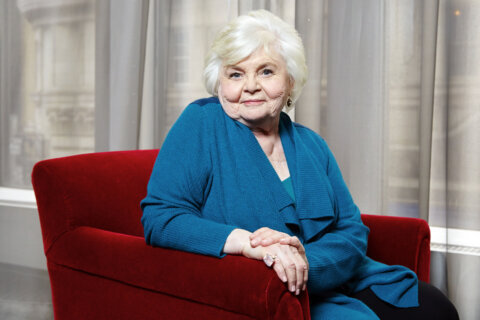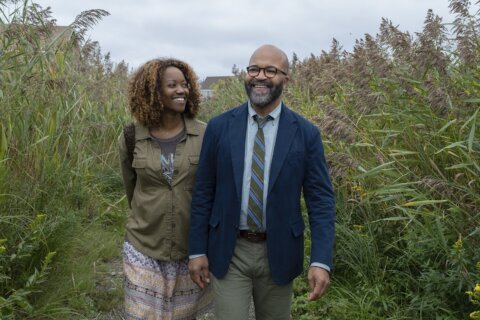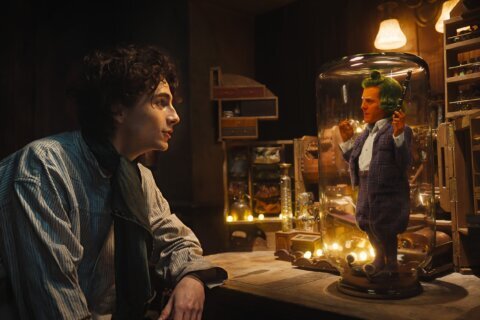Jason Fraley, WTOP film critic
WASHINGTON – Living in our nation’s capital, we’re on the cutting edge of the universe. Twice in the past month, the Newseum has rolled out the red carpet for star-studded Hollywood premieres.
First came Kathryn Bigelow’s “Zero Dark Thirty” on Jan. 8. Now, it’s the new web series “House of Cards,” starring Kevin Spacey (“The Usual Suspects”) as House Majority Whip Francis Underwood, a manipulative politician who will do whatever it takes to become president of the United States.
The real novelty of “House of Cards” is its place as the first original series by Netflix, the online video rental and streaming service that’s now throwing its hat in the ring as a bona fide content creator. All 13 episodes of the first season become available online today.
Who better to lead this digital revolution than David Fincher, who directed “The Social Network” (2010) the same year social media sparked the Arab Spring, and Spacey, who routinely stars in the short films of rising filmmakers in his “First Shot” competition?
“Companies like Netflix have done tremendously well at being portholes for content,” Spacey said. “If they want to compete, they’re gonna have to start producing their own work.”
“Everything’s going to be live-streamed eventually,” said co-star Robin Wright (“Forrest Gump”). “It’s the new medium. It’s the trend. We’re not going to be the last that does this format … delivering to the consumer what they already do anyway. They’ll sit in bed with their computer over a weekend and watch two seasons of ‘Mad Men’ back to back, or ‘The Sopranos.’ I’ve been hearing that for years.”
“That tells us two things,” Spacey said. “The notion that the American public has no attention span is completely wrong, because people are gobbling up these long plot stories. And secondly, this is an opportunity … for the film and television industry to learn the lesson that the music industry didn’t learn, which is to give the audience what they want, when they want it, at a reasonable price, in the form they want it, and they’ll buy it. They won’t steal it.”
Perhaps Fincher took heed from Napster’s Sean Parker (Justin Timberlake) and Facebook’s Mark Zuckerberg (Jesse Eisenberg) in “The Social Network.” Perhaps he learned from the “pay what you want” album “In Rainbows” (2007) by Radiohead, whose “Creep” made for a powerful “Social Network” trailer. Or, perhaps he’s just keenly aware of the changing landscape of his own industry. Whatever the reason, this urge for digital revolution is key to “Cards,” where the fictional Washington Herald newspaper fights to survive in a print industry that’s going extinct in the digital world.
“One of the themes we’ve come upon in this series is how the media world is changing,” said actor Sebastian Arcelus, who plays the Herald’s deputy editor Lucas Goodwin. “(Our characters) struggle with the push and pull of what new media and the current public demand, and what we demand of ourselves in terms of putting out a proper, pure and ethical paper.”
The plot unfolds between these journalists and the politicians they cover. Zoe Barnes (Kate Mara, “American Horror Story”) is a rising investigative reporter who strikes an alliance with Spacey’s crooked politician, helping each other on the Q.T. and very hush hush, to quote another Spacey flick.
“Basically they use each other in certain ways to achieve goals and it ends up working out pretty well for her,” Mara said, sharing a laugh with me and WTOP’s Michelle Basch along the red carpet.
Thus, “House of Cards” feels like “The Newsroom” meets “The West Wing,” both written by Fincher’s “Social Network” collaborator Aaron Sorkin. Head writer Beau Willimon (Oscar nominee, “The Ides of March”) gives Sorkin a run for his political-writing money, lending slick dialogue to his adaptation of the 1990 BBC series from Michael Dobbs’ novel.
Much of this comes in the form of narration, a device Fincher knows well from Morgan Freeman in “Se7en” (1995), Ed Norton in “Fight Club” (1999) and Brad Pitt in “The Curious Case of Benjamin Button” (2008). In “House of Cards,” the narration occasionally overreaches in its hardboiled spitfire, but no more than “Double Indemnity” (1944), “His Girl Friday” (1940) or any of the other classics. The melodrama of the tone almost demands it.
Wright gets the best quips as Spacey’s calculating wife Claire in a fitting reunion with Fincher after “The Girl with the Dragon Tattoo” (2011), which starred Kate Mara’s sister, Rooney. Early plot trends suggest Wright and Mara will both vie for Spacey’s affections, particularly in a passive-aggressive scene where Wright tells Mara: “Be careful driving home. The roads are icy.” Just like her soul.
Wright and Tom Hanks may have been like “peas and carrots” in “Gump,” but that parternship is apples and oranges compared to Wright and Spacey. Wright describes her character as the Lady Macbeth to his Richard III, two power-hungry individuals joining forces to get what they want. When he says, “We’ll have a lot of nights like this, making plans, very little sleep,” she says, “I expected that.” When he says, “A lot of irons in the fire,” she says, “I like irons. But I love fire.”
“They’re both leaders and the ends justify the means,” Wright said. “They will do whatever it takes to get ahead, they have each other’s back, and they have a mutual respect for one another as husband and wife and man and woman. They’re a team.”
Willimon deserves immense credit for crafting such nuanced characters. If the pilot is any indication, we’re in for a world of backstabbing and dealmaking on the way up the corrupt Washington ladder.
“With 26 hours committed and two seasons up front, we knew we could do really sophisticated storytelling,” Willimon said. “Things that happen very early on in the first season could pay off in a significant, satisfying way toward the end of Season 2. You can’t bank on that sort of storytelling when you’re playing the ratings game.”
The 13 episodes are divided between four directors: Fincher (“Fight Club”), James Foley (“Glengary Glenn Ross”), Carl Franklin (“Devil in a Blue Dress”) and Joel Schumacher (“Falling Down”).
“I was really blown away by the pilot and the second episode,” said Kristen Connolly (“The Cabin in the Woods”), who was not in the pilot, but who will appear as a congressman’s headstrong assistant, I’m guessing similar to Christina Hendricks in “Mad Men.” “I think it’s really special what David and Beau have done with an hour of television. It feels like a movie. … I’m on a tight leash with what I’m allowed to say, I don’t want to get in trouble.”
Oh yes, that’s right. The first rule about “Fight Club” is that you don’t talk about “House of Cards.”
Fincher’s pilot thrives off direct addresses to the camera with Spacey talking straight to the audience, breaking the “fourth wall” like a true demolition man. Spacey said it reminded him of “Ferris Bueller” (1986), and it’s arguably just as funny. At one point, Spacey tells us, “Watch, I bet he’ll say …” and when his co-star inevitably does, Spacey shoots a quick look back at us as if to say, “I told you so.”
Throughout the pilot, Fincher quietly crumbles directing conventions like a soft breeze blowing a plastic bag against a house of cards. Rather than cut to a close-up of a text message, he lets the message pop up on screen like a block quote. Later, he plays with the notion of diegetic sound (emanating from an on-screen source), showing Spacey listening to music at a performing arts center, then cutting to a shot of him in headphones as if he’s listening to the same music. The joke’s on us, as Fincher’s slow disclosure reveals Spacey playing a violent video game via those same headphones.
In true Fincher style, the directorial prowess continues even into the opening credits, just like the serial killer notebooks at the start of “Se7en” or the ink-blot opening of “Dragon Tattoo.” Similarly, “House of Cards” opens each episode with symbolic shadows creeping across famous D.C. monuments, suggesting a dark side to the city’s statuesque aura.
“D.C. to me is an endlessly fascinating place,” Willimon said. “Some of the people it draws go on to do great things, and others become influenced by power in ways that begins to erode their ethos. As a storyteller, I find that interesting. As a human being, I find it as troubling and as tragic as anyone else. But believe it or not, as dark as “Ides of March” is and as dark as “House of Cards” is, I’m an optimist. I think progress can be achieved, and I think this town is still capable of it.”
The local setting was a big convenience for Michael Alban, a native of Westminster, Md., longtime resident of Baltimore and currently a Georgetown resident who splits time in New York, where he studied acting at The Ward Studio. Alban began doing background acting in feature films that came to D.C., and to his surprise, he found himself on screen with Renee Zellweger in “My One & Only” (2009) and Russell Crowe in “State of Play” (2009), then standing in for Ben Affleck in “Argo” (2012).
In “House of Cards,” Alban landed a speaking part in the ninth episode as a senior staffer for the vice president, played by Corey Stoll, whom you know as Hemingway in “Midnight in Paris” (2011).
“For me, my job was just to hit my lines every time, be where I needed to be, and stay out of the way,” Alban said. “When I first walked in for rehearsal, James (Foley) said, ‘You’re my staffer huh? You think you can open a door?’ And I said, ‘Yeah, I’ve done that a few times.'”
Alban also served as a stand-in for several episodes directed by Fincher.
“I was standing behind Fincher as he was behind the monitor, and I was blown away … He must have done 20 takes with this guy, but damned if Fincher didn’t get a better take out of him. Around 30 takes, the actor started having diminishing returns, and Fincher recognized it immediately.”
Fincher and crew used the The Baltimore Sun building to stage the offices of the Washington Herald and used Havre de Grace, Md., as the South Carolina hometown of Spacey’s character. The Aegis, an affiliate of the Sun, reported the crew leased 15,000 square feet of office space and more than 130,000 square feet of warehouse space. The interiors of the White House and Capitol were built on a brand new sound stage in Joppa, Md.
Netflix clearly made a huge investment for the $100 million, two-season production, and local residents will reap the benefits. The Baltimore Sun reports “House of Cards” is expected to bring a $70 million boost to the state economy. Gov. Martin O’Malley has also proposed a major boost in the state’s film and TV tax credit from $7.5 million to $25 million in his fiscal 2014 budget.
This local flavor will no doubt thrill local audiences, who will play “I Spy” with all of the pick-up shots of real-life locations. As I exited the Newseum premiere Tuesday night and stared down Pennsylvania Avenue toward the Capitol, I realized I was standing in the same spot I just saw on screen, only now under the gorgeous glow of Washington streetlights. I thought back to the bouquets of red roses sitting on the Newseum tables just inside the lobby, as if they were planted there by Spacey himself.
On this particular night, D.C. had become the epitome of American beauty, a city on the cutting edge of the universe. “House of Cards” is getting out in front of mankind’s technological arc, as Netflix follows Underwood’s political motto in an attempt to change the entire entertainment industry: “Take a step back. Look at the bigger picture. That’s how you devour a whale. One bite at a time.”
“We don’t know yet whether we’re gonna be the big thud heard around the world … but it does seem it’s the direction it’s heading in, so I’m always happy to be involved in something early on,” Spacey said, flashing a mischievous smile and giving me the last word on the red carpet line. “It’s pretty cool.”
Follow WTOP Film Critic @JasonFraleyWTOP on Twitter or check out his blog The Film Spectrum.
(Copyright 2013 by WTOP. All Rights Reserved.)








